Examining the Density and Diversity of Human Activity in the Built Environment: The Case of the Pearl River Delta, China
Abstract
1. Introduction
- How can we determine the density and diversity of human activity in built-up areas?
- Which factors, besides urban scale, indicate the high efficiency of a city?
2. Literature Review
2.1. International Perspectives on Ghost Towns
- Property market dynamics: Exploring how robust demands, the specific geography of the property market and households’ financial strategies can contribute to an oversupply of housing and other types of property;
- New-town projects: Explaining why new town projects that were planned on a large scale, led by a growth orientation and featuring an abundance of public infrastructure may drive the emergence of ghost towns;
- Land use: Considering land use to discern patterns that reveal a surge in built-up space relative to population.
2.2. Focusing on Human Activity in Built-Up Areas in China
2.3. Measuring Human Activity in Built-Up Areas
2.4. Human Activity Factors in Built-Up Areas
3. Study Area and Methodology
3.1. Study Area
3.2. Research Approach
3.2.1. Data Collection and Processing
3.2.2. Mapping the Density and Diversity of Human Activity
3.2.3. Examining the Related Factors
4. Results
4.1. Distribution of Human Activity
4.2. ComprehensiveEevaluation of Activity Density
4.3. Comprehensive Evaluation of Activity Diversity
4.4. Region of Low Human Activity Density
5. Regression Analysis for the Related Factors
5.1. Selecting the Variables
5.2. Modeling the Regression Analysis
5.3. Explaining Dynamics for the Regression Results
6. Conclusion and Discussion
- 1)
- This study successfully processes three kinds of data (i.e., the data of residential, business and recreational activities) to evaluate patterns of human behavior and identify ghost towns. This offers a more solid and innovative angle to determine the existence and features of ghost towns than research that explores this topic on a micro-level and solely relies on residential activities, such as in Chi et al. [8], Jin et al. [11] and Zheng et al. [12];
- 2)
- In this study, we explicitly analyzed how three core factors (i.e., urban scale, compactness of urban morphology and administrative hierarchy) affect the diversity and density of human activity in the PRD. This helps to further the understanding of ghost towns because Woodworth and Wallace [4], Shepard [9] and Sorace and Hurst [10] are in agreement that there is not yet any consensus in the definition and factors leading to this phenomenon. Furthermore, our analysis provides a valuable reference for cities worldwide in terms of considering how to avoid ghost town development and ensure urban sustainability.
Author Contributions
Funding
Conflicts of Interest
References
- Batty, M. Empty buildings, shrinking cities and ghost towns. Environ. Plan. B Plan. Des. 2016, 43, 3–6. [Google Scholar] [CrossRef]
- Chen, M.; Liu, W.; Lu, D. Challenges and the way forward in China’s new-type urbanization. Land Use Policy 2016, 55, 334–339. [Google Scholar] [CrossRef]
- Wang, Q.; Li, R.; Cheong, K.C. Shandong’s Yintan town and China’s “ghost city” phenomenon. Sustainability 2019, 11, 4584. [Google Scholar] [CrossRef]
- Woodworth, M.D.; Wallace, J.L. Seeing ghosts: Parsing China’s “ghost city” controversy. Urban Geogr. 2017 38, 1270–1281. [CrossRef]
- Hui, E.C.M.; Wu, Y.; Deng, L.; Zheng, B. Analysis on coupling relationship of urban scale and intensive use of land in China. Cities 2015, 42, 63–69. [Google Scholar] [CrossRef]
- Gao, J.; Wei, Y.; Chen, W.; Yenneti, K. Urban land expansion and structural change in the Yangtze River Delta, China. Sustainability 2015, 7, 10281–10307. [Google Scholar] [CrossRef]
- Li, H.; Wei, Y.D.; Liao, F.H.; Huang, Z. Administrative hierarchy and urban land expansion in transitional China. Appl. Geogr. 2015, 56, 177–186. [Google Scholar] [CrossRef]
- Chi, G.; Liu, Y.; Wu, H. Ghost cities analysis based on positioning data in China. arXiv 2015, arXiv:1510.08505. [Google Scholar]
- Shepard, W. Ghost Cities of China: The Story of Cities without People in the World’s Most Populated Country; Zed Books: London, UK, 2015. [Google Scholar]
- Sorace, C.; Hurst, W. China’s phantom urbanisation and the pathology of ghost cities. J. Contemp. Asia 2015, 46, 304–322. [Google Scholar] [CrossRef]
- Shi, Y.; Xie, M. Comprehensive evaluation of university town’s land use based on the entropy method: A case study of Guangzhou university town. Mod. Urban Res. (Chin.) 2013, 1, 98–102. [Google Scholar]
- Han, S.S. Urban expansion in contemporary China: What can we learn from a small town? Land Use Policy 2010, 27, 780–787. [Google Scholar] [CrossRef]
- Jin, X.; Long, Y.; Sun, W.; Lu, Y.; Yang, X.; Tang, J. Evaluating cities’ vitality and identifying ghost cities in China with emerging geographical data. Cities 2017, 63, 98–109. [Google Scholar] [CrossRef]
- Zheng, Q.; Zeng, Y.; Deng, J.; Wang, K.; Jiang, R.; Ye, Z. “Ghost cities” identification using multi-source remote sensing datasets: A case study in Yangtze River Delta. Appl. Geogr. 2017, 80, 112–121. [Google Scholar] [CrossRef]
- Wang, J. A spatial-panel econometric analysis on the relationship between regional socio-economic development and construction land use in China. China Land Sci. (Chin.) 2013, 27, 79–85. [Google Scholar]
- Tian, L.; Shen, T. Evaluation of plan implementation in the transitional China: A case of Guangzhou city master plan. Cities 2011, 28, 11–27. [Google Scholar] [CrossRef]
- Tian, L. Land urbanization of china at the cross road: A review on the evolution since the establishment of land use right system and the prospect of its transformation. City Plan. Rev. (Chin.) 2013, 19, 109–117. [Google Scholar]
- Harsay, J.G. Efficiency, adaptability, and compatibility in multiple land use. Environ. Manag. 1978, 2, 204–208. [Google Scholar] [CrossRef]
- Gingrich, S.; Niedertscheider, M.; Kastner, T.; Haberl, H.; Cosor, G.; Krausmann, F.; Kuemmerle, T.; Müller, D.; Reith-Musel, A.; Jepsen, M.R.; et al. Exploring long-term trends in land use change and aboveground human appropriation of net primary production in nine European countries. Land Use Policy 2015, 47, 426–438. [Google Scholar] [CrossRef]
- Schneider, A.; Woodcock, C.E. Compact, dispersed, fragmented, extensive? A comparison of urban growth in twenty-five global cities using remotely sensed data, pattern metrics and census information. Urban Stud. 2008, 45, 659–692. [Google Scholar] [CrossRef]
- Zitti, M.; Ferrara, C.; Perini, L.; Carlucci, M.; Salvati, L. Long-term urban growth and land use efficiency in Southern Europe: Implications for sustainable land management. Sustainability 2015, 7, 3359–3385. [Google Scholar] [CrossRef]
- Xie, H.; Wang, W. Exploring the spatial-temporal disparities of urban land use economic efficiency in China and its influencing factors under environmental constraints based on a sequential slacks-based model. Sustainability 2015, 7, 10171–10190. [Google Scholar] [CrossRef]
- Zeng, C.; Yang, L.; Dong, J. Management of urban land expansion in China through intensity assessment: A big data perspective. J. Clean. Prod. 2017, 153, 637–647. [Google Scholar] [CrossRef]
- Wheaton, W.C. Land use and density in cities with congestion. J. Urban Econ. 1998, 43, 258–272. [Google Scholar] [CrossRef]
- Du, J.; Thill, J.-C.; Peiser, R.B. Land pricing and its impact on land use efficiency in post-land-reform China: A case study of Beijing. Cities 2016, 50, 68–74. [Google Scholar] [CrossRef]
- Jacques, C.; El-Geneidy, A. Does travel behavior matter in defining urban form? A quantitative analysis characterizing distinct areas within a region. J. Transp. Land Use 2014, 7, 1. [Google Scholar] [CrossRef]
- Lee, S.; Lee, B. The influence of urban form on GHG emissions in the U.S. household sector. Energy Policy 2014, 68, 534–549. [Google Scholar] [CrossRef]
- Banerjee, U.; Hine, J. Identifying the underlying constructs linking urban form and travel behaviour using a grounded theory approach. Int. J. Environ. Sci. Technol. (Tehran) 2014, 11, 2217–2232. [Google Scholar] [CrossRef][Green Version]
- Henderson, J.V. The sizes and types of cities. Am. Econ. Rev. 1974, 64, 640–656. [Google Scholar]
- Fujita, M.; Krugman, P.; Venables, A. The Spatial Economy: Cities, Regions and International Trade; MIT Press: Cambridge, MA, USA, 1999. [Google Scholar]
- Glaeser, E. Triumph of the City: How Our Greatest Invention Makes US Richer, Smarter, Greener, Healthier and Happier; Macmillan: Oxford, UK, 2011. [Google Scholar]
- Servillo, L.; Atkinson, R.; Russo, A.; Sýkora, L.; Demazière, C.; Hamdouch, A. TOWN, Small and Medium Sized Towns in Their Functional Territorial Context; ESPON: Leuven, Belgium, 2014. [Google Scholar]
- Hamdouch, A.; Demaziere, C.; Banovac, K. The Socio-economic profiles of small and medium-sized towns: Insights from European case studies. Tidschr. Econ. Soc. Geogr. 2017, 108, 456–471. [Google Scholar] [CrossRef]
- Yang, X.; Wang, D. Disparities of efficiency of economy and growth of productivity for different scale cities in China. Manag. World (Chin.) 2002, 3, 9–12. [Google Scholar]
- Zhao, K.; Xu, T.; Li, P.; Zhang, A. Disparities and convergence of land productivity of different scale cities: Based on panel data of 265 cities in China. J. Arid Land Resour. Environ. (Chin.) 2015, 29, 1–6. [Google Scholar]
- Gospodini, A. Urban Design, Urban Space Morphology, Urban Tourism: An Emerging New Paradigm Concerning Their Relationship. Eur. Plan. Stud. 2001, 9, 925–934. [Google Scholar] [CrossRef]
- Kulish, M.; Richards, A.; Gillitzer, C. Urban Structure and Housing Prices: Some Evidence from Australian Cities; Reserve Bank of Australia: Canberra, Australia, 2011. [Google Scholar]
- Frank, L.D.; Engelke, P.O. The Built Environment and Human Activity Patterns: Exploring the Impacts of Urban Form on Public Health. J. Plan. Lit. 2016, 16, 202–218. [Google Scholar] [CrossRef]
- Calthorpe, P. New urbanism and the apologists for sprawl. Places Forum Des. Public Realm 2000, 13, 67–69. [Google Scholar]
- Walmsley, A. Greenways: Multiplying and diversifying in the 21st century. Landsc. Urban Plan. 2006, 76, 252–290. [Google Scholar] [CrossRef]
- Shi, Y.; Sun, X.; Zhu, X.; Li, Y.; Mei, L. Characterizing growth types and analyzing growth density distribution in response to urban growth patterns in peri-urban areas of Lianyungang City. Landsc. Urban Plan. 2012, 105, 425–433. [Google Scholar] [CrossRef]
- Longley, P.A.; Batty, M.; Shepherd, J. The size, shape and dimension of urban settlements. Trans. Inst. Br. Geogr. 1991, 16, 75. [Google Scholar] [CrossRef]
- Batty, M. Exploring isovist fields: Space and shape in architectural and urban morphology. Environ. Plan. B Plan. Des. 2001, 28, 123–150. [Google Scholar] [CrossRef]
- Chen, Y. Derivation of the functional relations between fractal dimension of and shape indices of urban form. Comput. Environ. Urban Syst. 2011, 35, 442–451. [Google Scholar] [CrossRef]
- Pili, S.; Grigoriadis, E.; Carlucci, M.; Clemente, M.; Salvati, L. Towards sustainable growth? A multi-criteria assessment of (changing) urban forms. Ecol. Indic. 2017, 76, 71–80. [Google Scholar] [CrossRef]
- Reid, R.S.; Tomich, T.P.; Xu, J. Linking land-change science and policy: Current lessons and future integration. In Land-Use and Land-Cover Change; Geist, E.F.L., Ed.; Springer: Berlin, Germany, 2006; pp. 157–171. [Google Scholar]
- Li, X.; Love, P.E.D. Employing land value capture in urban rail transit public private partnerships: Retrospective analysis of Delhi’s airport metro express. Res. Transp. Bus. Manag. 2020, 32, 100431. [Google Scholar] [CrossRef]
- Mu, R.; de Jong, M.; Koppenjan, J. Assessing and explaining interagency collaboration performance: A comparative case study of local governments in China. Public Manag. Rev. 2018, 21, 581–605. [Google Scholar] [CrossRef]
- Ma, Z. Historical Urban Geography in China; Shandong Education Presss: Jinan, China, 1998. [Google Scholar]
- Zhou, C. Research on Cities in Han Dynasty; Renmin Press: Beijing, China, 2001. [Google Scholar]
- Wei, H. The administrative hierarchy and growth of urban scale in China. Chin. J. Urban Environ. Stud. 2015, 3, 1550001. [Google Scholar] [CrossRef]
- Tian, L.; Ma, W. Government intervention in city development of China: A tool of land supply. Land Use Policy 2009, 26, 599–609. [Google Scholar] [CrossRef]
- Tian, L. Land use dynamics driven by rural industrialization and land finance in the peri-urban areas of China: “The examples of Jiangyin and Shunde”. Land Use Policy 2015, 45, 117–127. [Google Scholar] [CrossRef]
- Tian, L. Urbanization of land in urbanization process of China: Boon or bane? City Plan. Rev. (Chin.) 2011, 17, 11–12. [Google Scholar]
- Xu, Y.; Tang, Q.; Fan, J.; Bennett, S.J.; Li, Y. Assessing construction land potential and its spatial pattern in China. Landscape Urban Plan. 2011, 103, 207–216. [Google Scholar] [CrossRef]
- Wang, J.C.L.; Zhang, X.; Shan, Z. Survey of data-centric smart city. J. Comput. Res. Dev. 2014, 51, 239–259. [Google Scholar]
- Du, J.; Thill, J.-C.; Peiser, R.B.; Feng, C. Urban land market and land-use changes in post-reform China: A case study of Beijing. Landscape Urban Plan. 2014, 124, 118–128. [Google Scholar] [CrossRef]
- Long, H. Land use policy in China: Introduction. Land Use Policy 2014, 40, 1–5. [Google Scholar] [CrossRef]
- Wen, J.; Chuai, X.; Li, S.; Song, S.; Li, Y.; Wang, M.; Wu, S. Spatial heterogeneity of the carbon emission effect resulting from urban expansion among three coastal agglomerations in China. Sustainability 2019, 11, 4590. [Google Scholar] [CrossRef]
- DeLyser, D.; Sui, D. Crossing the qualitative-quantitative divide II. Prog. Hum. Geogr. 2012, 37, 293–305. [Google Scholar] [CrossRef]
- Miller, H.J.; Goodchild, M.F. Data-driven geography. Geojournal 2014, 80, 449–461. [Google Scholar] [CrossRef]
- Grand, A.; Wilkinson, C.; Bultitude, K.; Winfield, A.F. Mapping the hinterland: Data issues in open science. Public Underst. Sci. 2016, 25, 88–103. [Google Scholar] [CrossRef]
- Ma, H.; Meng, Y.; Xing, H.; Li, C. Investigating road-constrained spatial distributions and semantic attractiveness for area of interest. Sustainability 2019, 11, 4624. [Google Scholar] [CrossRef]
- Zhao, M.; Derudder, B.; Zhang, P.; Zhong, P. An expanded bipartite network projection algorithm for measuring cities’ connections in service firm networks. Netw. Spat. Econ. 2019, 12, 1–20. [Google Scholar] [CrossRef]
- Bly, S.A.; Harrison, S.R.; Irwin, S. Media spaces: Bringing people together in a video, audio, and computing environment. CACM 1993, 36, 28–46. [Google Scholar] [CrossRef]
- Feick, R.; Robertson, C. A multi-scale approach to exploring urban places in geotagged photographs. Comput. Environ. Urban Syst. 2015, 53, 96–109. [Google Scholar] [CrossRef]
- Nguyen, T.T.; Hwang, D.; Jung, J.J. Social tagging analytics for processing unlabeled resources: A case study on non-geotagged photos. In Intelligent Distributed Computing VIII; Camacho, D., Braubach, L., Venticinque, S., Badica, C., Eds.; Springer: Cham, Switzerland, 2015; Volume 570, pp. 357–367. [Google Scholar]
- Messeter, J. Social media use as urban acupuncture for empowering socially challenged communities. J. Urban Technol. 2015, 22, 79–96. [Google Scholar] [CrossRef]
- Kang, C.; Zhang, Y.; Ma, X.; Liu, Y. Inferring properties and revealing geographical impacts of intercity mobile communication network of China using a subnet data set. Int. J. Geogr. Inf. Sci. 2013, 27, 431–448. [Google Scholar] [CrossRef]
- Mor Naaman, A.X.Z.; Samuel, B.; Gilad, L. On the Study of Diurnal Urban Routines on Twitter. In Proceedings of the Sixth International AAAI Conference on Weblogs and Social Media, Dublin, Ireland, 4–7 June 2012. [Google Scholar]
- Batty, M. Big data, smart cities and city planning. Dialogues Hum. Geogr. 2013, 3, 274–279. [Google Scholar] [CrossRef] [PubMed]
- Comber, A.; See, L.; Fritz, S.; Van der Velde, M.; Perger, C.; Foody, G. Using control data to determine the reliability of volunteered geographic information about land cover. IJAEO 2013, 23, 37–48. [Google Scholar] [CrossRef]
- Frias-Martinez, V.; Frias-Martinez, E. Spectral clustering for sensing urban land use using Twitter activity. Eng. Appl. Artif. Intell. 2014, 35, 237–245. [Google Scholar] [CrossRef]
- Jiang, S.; Alves, A.; Rodrigues, F.; Ferreira, J.; Pereira, F.C. Mining point-of-interest data from social networks for urban land use classification and disaggregation. Comput. Environ. Urban Syst. 2015, 53, 36–46. [Google Scholar] [CrossRef]
- Živković, L.; Đorđević, A. Building a GIS platform for sustainable land management: A case study of the city of Čačak, Serbia. J. Urban Technol. 2016, 23, 29–46. [Google Scholar] [CrossRef]
- Jacobs, J. The Death and Life of Great American Cities; Random House: New York, NY, USA, 1961. [Google Scholar]
- Mamoru Taniguchi, T.I. The compact city as a means of reducing reliance on the car: A model-based analysis for a sustainable urban layout. In Spatial Planning, Urban Form and Sustainable Transport; Williams, K., Ed.; Routledge: London, UK, 2005. [Google Scholar]
- Mahajan, A.; Potnis, N.; Gopalan, K.; Wang, A.A. Urban Mobility Models for VANETs. Available online: https://osnet.cs.binghamton.edu/publications/mahajan06urban.pdf (accessed on 25 April 2020).
- Tablada, A.; De Troyer, F.; Blocken, B.; Carmeliet, J.; Verschure, H. On natural ventilation and thermal comfort in compact urban environments—The Old Havana case. Build. Environ. 2009, 44, 1943–1958. [Google Scholar] [CrossRef]
- Huang, J.; Lu, X.X.; Sellers, J.M. A global comparative analysis of urban form: Applying spatial metrics and remote sensing. Landsc. Urban Plan. 2007, 82, 184–197. [Google Scholar] [CrossRef]
- Colantoni, A.; Grigoriadis, E.; Sateriano, A.; Sarantakou, E.; Salvati, L. Back to Von Thunen: A Southern European perspective on mono-centric urban growth, economic structure and non-urban land decline. Int. Plan. Stud. 2016, 22, 173–188. [Google Scholar] [CrossRef]
- Tannier, C.; Thomas, I. Defining and characterizing urban boundaries: A fractal analysis of theoretical cities and Belgian cities. Comput. Environ. Urban Syst. 2013, 41, 234–248. [Google Scholar] [CrossRef]
- Fei, X. Small Towns, Grand Strategies; Tianjin People’s Publishing House: Tianjin, China, 1986. [Google Scholar]
- Shi, Y. The balance urbanization mode of Germany and the system bottlenecks of development of Chinese small towns. Econ. Geogr. (Chin.) 2015, 35, 54–70. [Google Scholar]
- Lu, M. Big Country Big City: The Unification of Contemporary China, Development and Balance; People’s Publishing House of Shanghai: Shanghai, China, 2016. [Google Scholar]
- Zhang, Q.; Wallace, J.; Deng, X.; Seto, K.C. Central versus local states: Which matters more in affecting China’s urban growth? Land Use Policy 2014, 38, 487–496. [Google Scholar] [CrossRef]
- Batty, M.; Vargas, C.; Smith, D.; Serras, J.; Reades, J.; Johansson, A. SIMULACRA: Fast land use—Transportation models for the rapid assessment of urban futures. Environ. Plan. B Plan. Des. 2013, 40, 987–1002. [Google Scholar] [CrossRef]
- Tian, L.; Xu, G.; Fan, C.; Zhang, Y.; Gu, C.; Zhang, Y. Analyzing mega city-regions through integrating urbanization and eco-environment systems: A case study of the Beijing-Tianjin-Hebei region. Int. J. Environ. Res. Public Health 2019, 16, 114. [Google Scholar] [CrossRef] [PubMed]
- Moreno, E.L.; Blanco, Z.G. Ghost cities and empty houses: Wasted prosperity. Am. Int. J. Soc. Sci. 2014, 3, 207–216. [Google Scholar]
- Seely-Gant, K.L.M. Exploring bias and error in big data research. Wash. Acad. Sci. 2015, 101, 29–37. [Google Scholar]
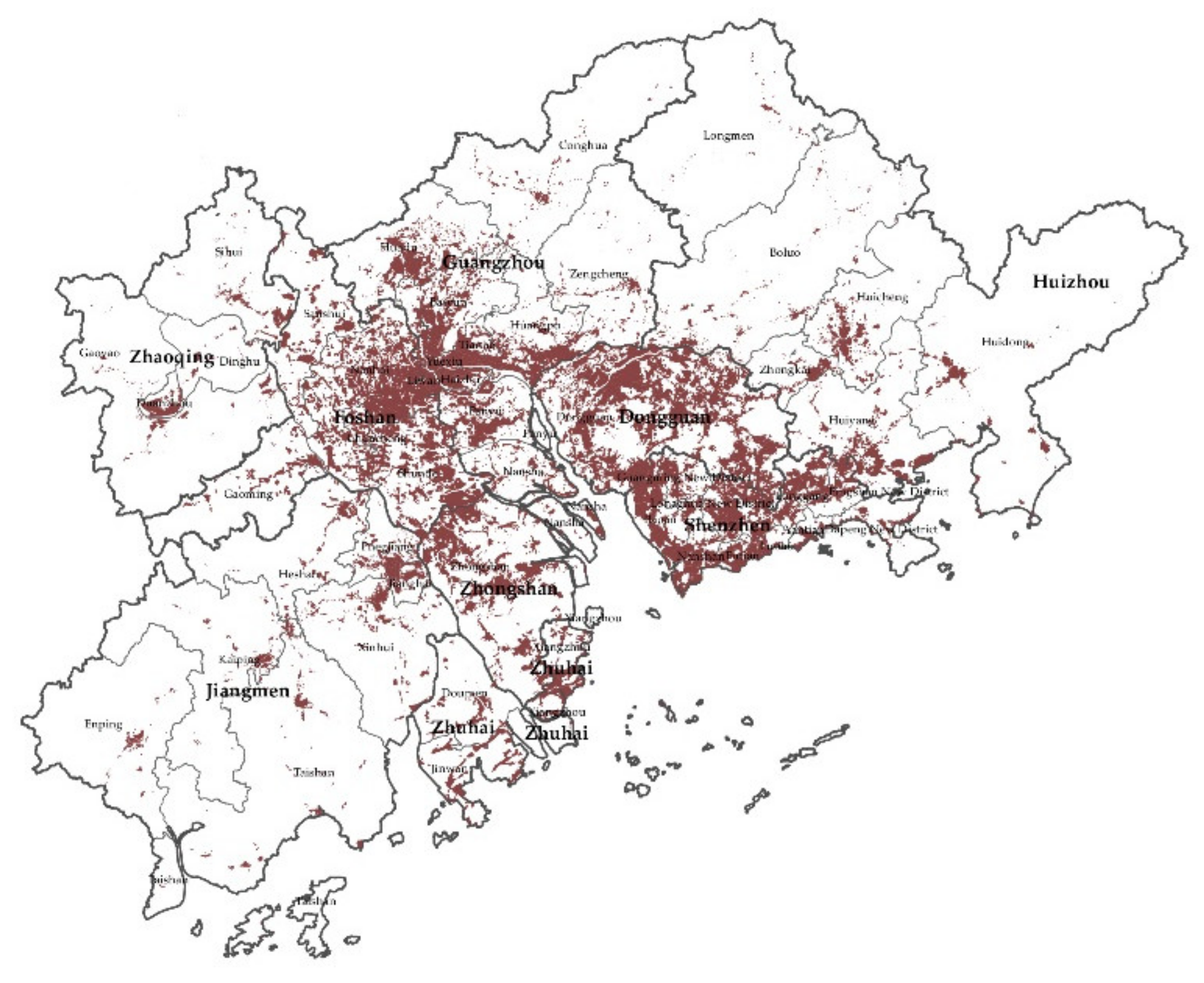
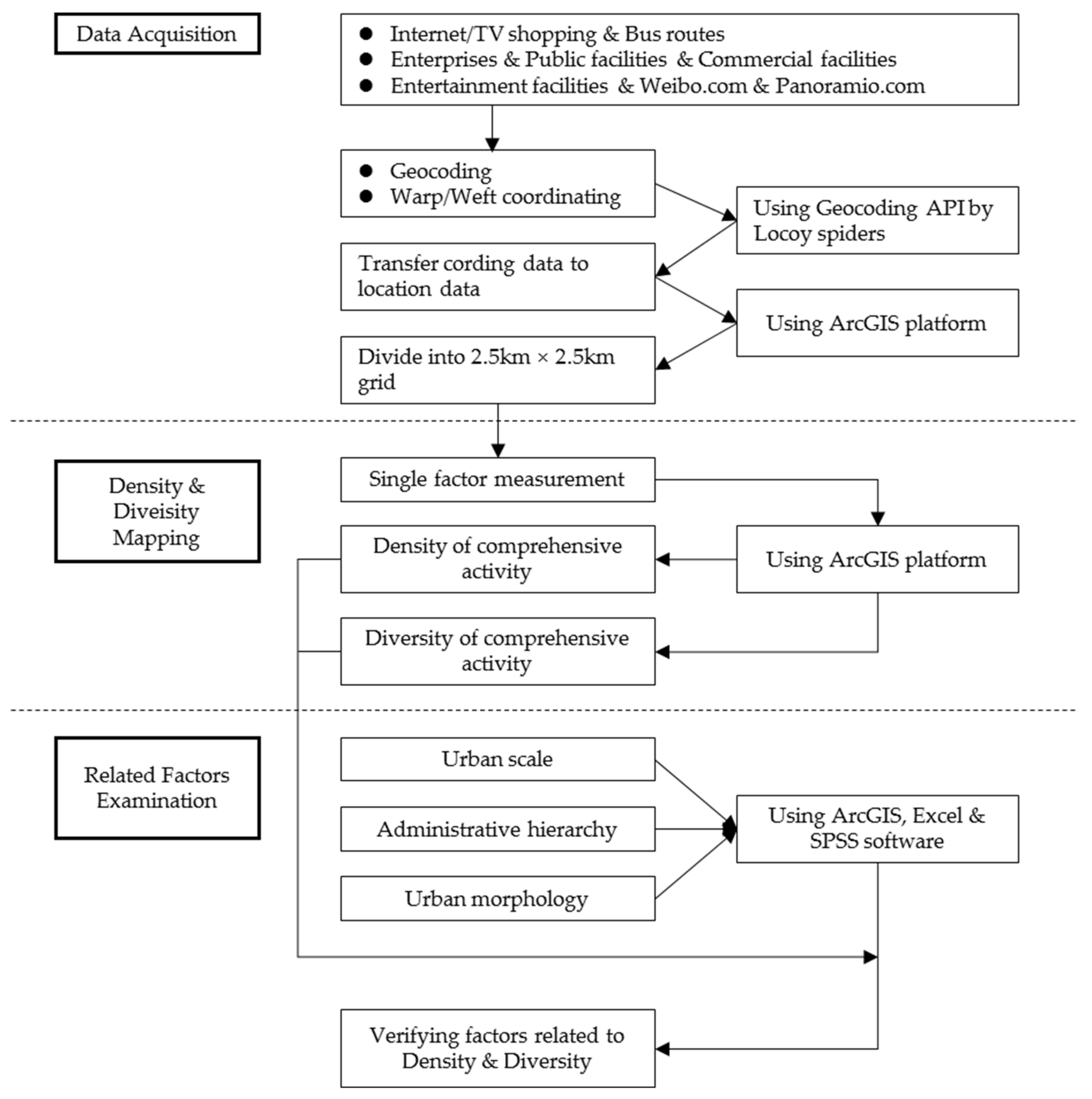
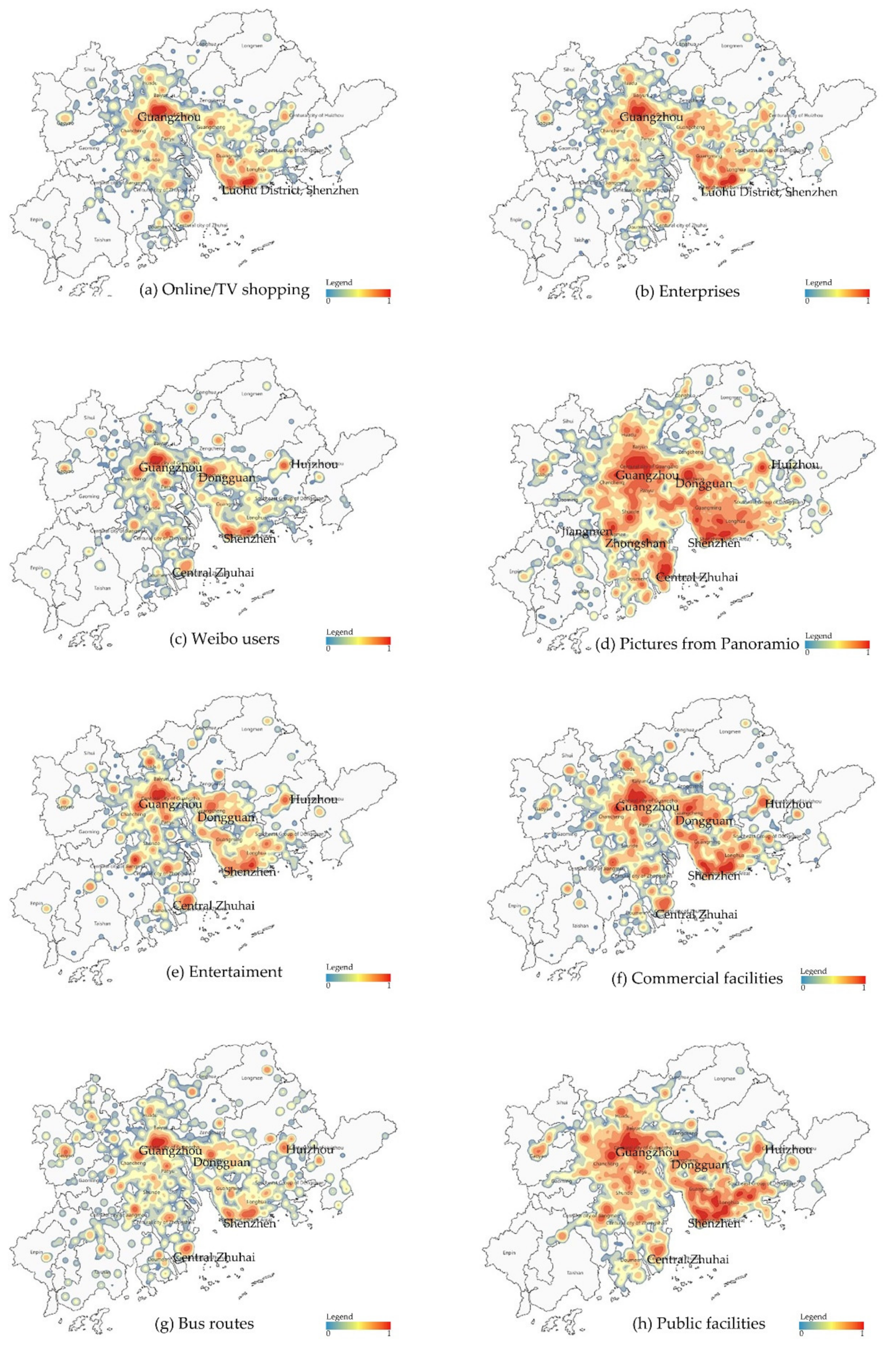

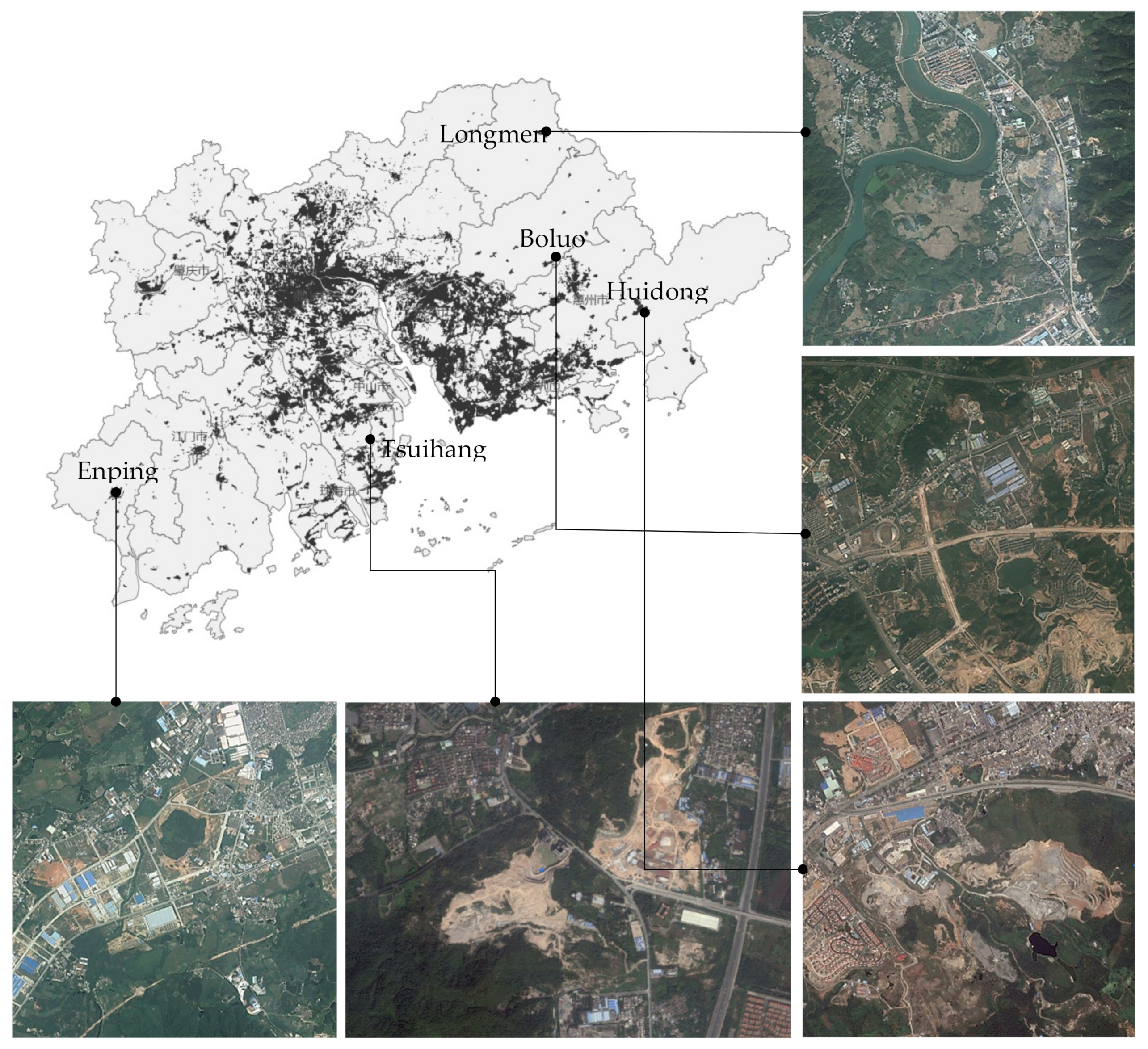
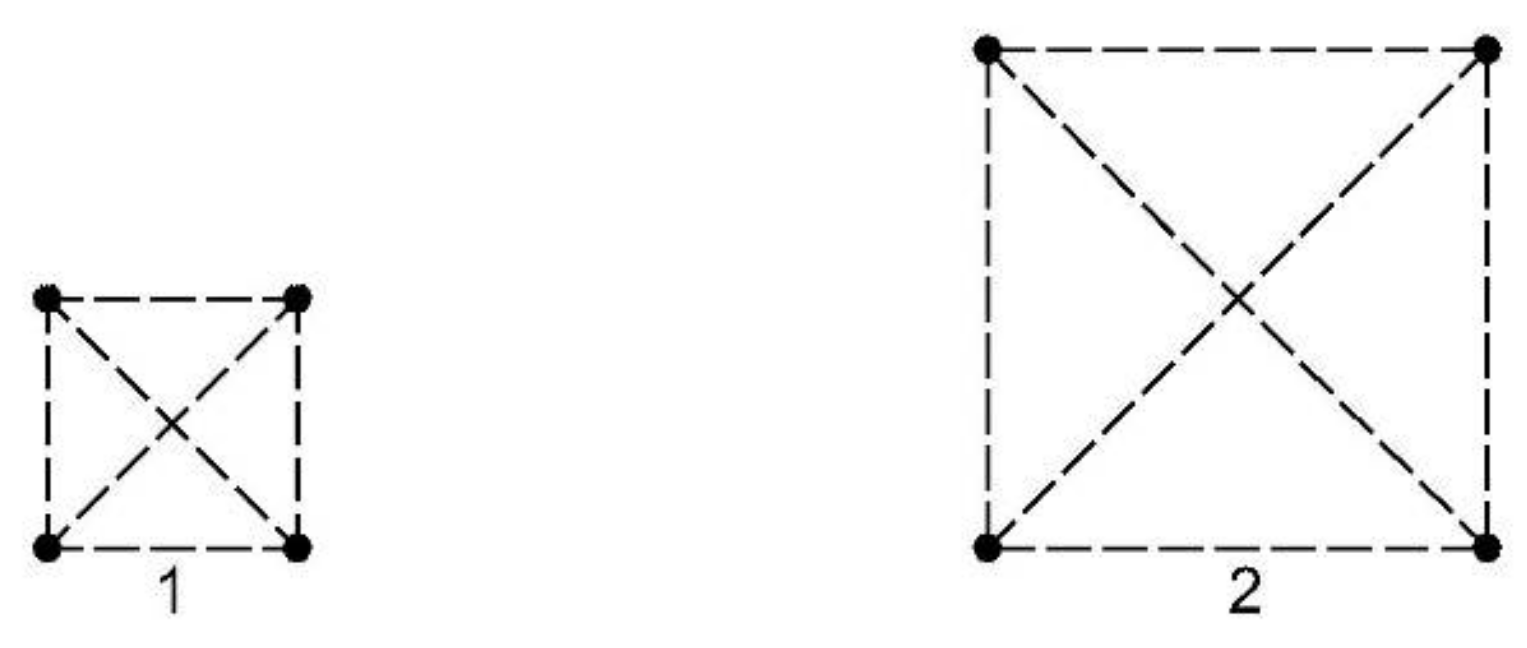
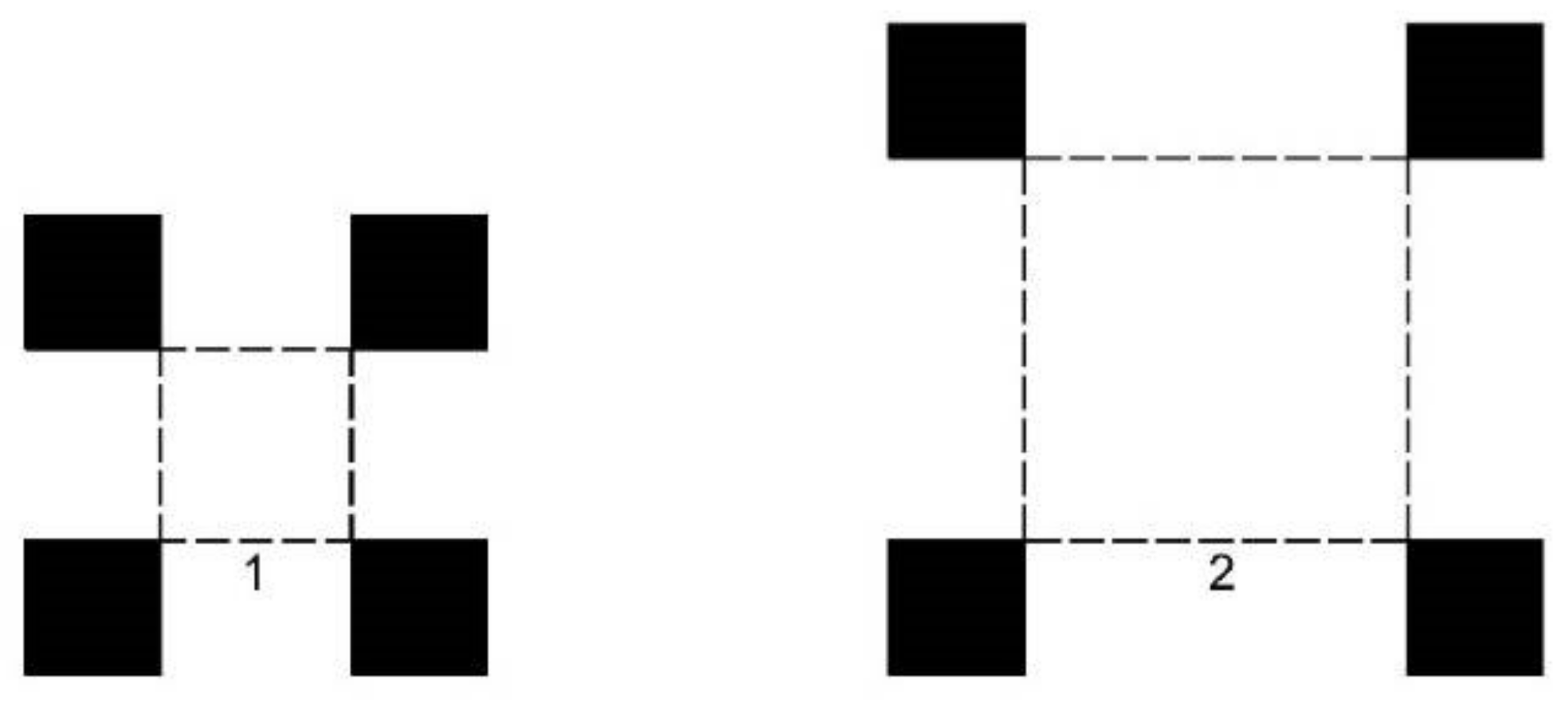
| Variable | N | Min | Max | Mean | Std. Error | |
|---|---|---|---|---|---|---|
| Urban scale | Scale_pop | 43 | 10.819 | 803.345 | 124.432 | 132.626 |
| Scale_area | 43 | 5.902 | 525.852 | 128.649 | 115.534 | |
| Administration | Admin_hierarchy | 43 | 1.000 | 5.000 | 1.907 | 1.250 |
| Admin_number | 43 | 90.000 | 2320.000 | 360.085 | 359.069 | |
| Morphology | Compact_d/dm | 43 | 0.391 | 69.019 | 32.971 | 13.732 |
| Compact_p/a | 43 | 0.257 | 0.778 | 0.357 | 0.079 | |
| Compact_d/a | 43 | 0.388 | 55.500 | 4.774 | 9.284 |
| Unstandardized Coefficients | Standardized Coefficients | t | Statistic of Collinearity | |||
|---|---|---|---|---|---|---|
| B | Std. Error | Tolerance | VIF | |||
| Intercept | −7.131 | 0.497 | −14.353 | |||
| Ln (Scale_pop) | 0.920 | 0.085 | 0.570 | 10.814 ** | 0.761 | 1.314 |
| Ln (Admin_hierarchy) | 0.572 | 0.134 | 0.231 | 4.275 ** | 0.727 | 1.375 |
| Ln (Compact_d/a) | −0.557 | 0.063 | −0.446 | −8.907 ** | 0.846 | 1.182 |
| Ln (Compact_p/a) | −0.030 | 0.087 | −0.016 | −0.339 | 0.961 | 1.040 |
| Kappa-value | 6.313 | |||||
| Adjusted r-squared | 0.911 | |||||
| N | 43 | |||||
| Unstandardized Coefficients | Standardized Coefficients | T | Statistic of Collinearity | |||
|---|---|---|---|---|---|---|
| B | Std. Error | Tolerance | VIF | |||
| Intercept | 0.768 | 0.112 | 6.866 | |||
| Ln (Scale_pop) | 0.040 | 0.019 | 0.209 | 2.078 * | 0.761 | 1.314 |
| Ln (Admin_hierarchy) | 0.024 | 0.030 | 0.081 | 0.787 | 0.727 | 1.375 |
| Ln (Compact_d/a) | −0.097 | 0.014 | −0.660 | −6.922 ** | 0.846 | 1.182 |
| Ln (Compact_p/a) | −0.071 | 0.020 | −0.325 | −3.634 ** | 0.961 | 1.040 |
| Kappa-value | 6.313 | |||||
| Adjusted r-squared | 0.677 | |||||
| N | 43 | |||||
© 2020 by the authors. Licensee MDPI, Basel, Switzerland. This article is an open access article distributed under the terms and conditions of the Creative Commons Attribution (CC BY) license (http://creativecommons.org/licenses/by/4.0/).
Share and Cite
Zhao, M.; Xu, G.; de Jong, M.; Li, X.; Zhang, P. Examining the Density and Diversity of Human Activity in the Built Environment: The Case of the Pearl River Delta, China. Sustainability 2020, 12, 3700. https://doi.org/10.3390/su12093700
Zhao M, Xu G, de Jong M, Li X, Zhang P. Examining the Density and Diversity of Human Activity in the Built Environment: The Case of the Pearl River Delta, China. Sustainability. 2020; 12(9):3700. https://doi.org/10.3390/su12093700
Chicago/Turabian StyleZhao, Miaoxi, Gaofeng Xu, Martin de Jong, Xinjian Li, and Pingcheng Zhang. 2020. "Examining the Density and Diversity of Human Activity in the Built Environment: The Case of the Pearl River Delta, China" Sustainability 12, no. 9: 3700. https://doi.org/10.3390/su12093700
APA StyleZhao, M., Xu, G., de Jong, M., Li, X., & Zhang, P. (2020). Examining the Density and Diversity of Human Activity in the Built Environment: The Case of the Pearl River Delta, China. Sustainability, 12(9), 3700. https://doi.org/10.3390/su12093700







